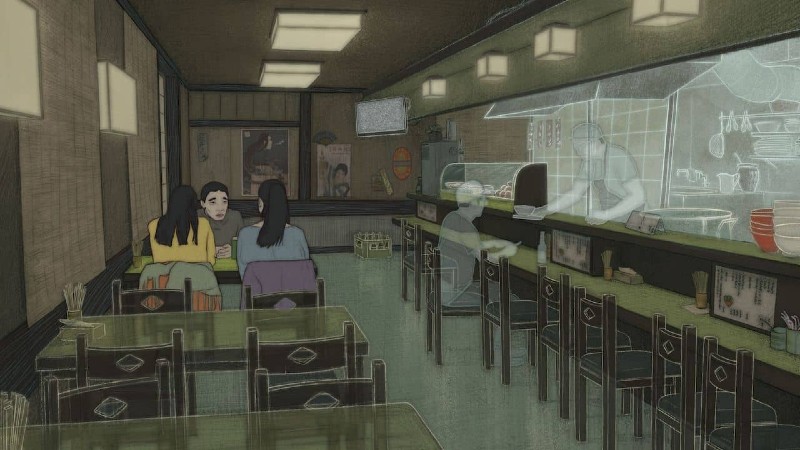




































This international co-production between France, Luxembourg, Canada, and the Netherlands was written and directed by Pierre Földes, and it is his feature-length debut. The narrative is split into various segments, each focusing on different central characters. Over the course of the 108-minute runtime, viewers are introduced to a lost cat, a giant frog and a tsunami as they help an unambitious salesman, his frustrated wife and a schizophrenic accountant save Tokyo from an earthquake and find meaning in their lives.
Instantly from just the very first sequence, Földes showcases his distinctive animation style (striking illustrations and dreamlike rotoscoping technique) and complex characters. The everyday life of Komura and Kyoko is interrupted by their inability to stay together. They are both in a world of their own, unable to coexist, resulting in Kyoko announcing that she is leaving. This breakup sends both characters on a journey of their own; self-discovery for newly-free Kyoko, whilst Komura becomes unmoored and lonely. He begins the search for the missing cat that once belonged to the couple, in an attempt to clear his mind.
Mr Katagiri is a distressed and exhausted accountant unsure about the future of his career, battling against the high-pressure and emotional battle that comes with the nine-to-five office job life. Feeling deflated after an anxiety-inducing day at work, Mr Katagiri makes his way home where he is surprisingly greeted by a human-sized frog sitting at his kitchen table, proposing that they team up in order to save Tokyo from another horrifying earthquake.

After this, the narrative weaves the characters’ storylines together in a natural, free-flowing way which allows the audience to gain an understanding of each personality and the depth of each storyline. Although the film does deal with some heavy topics – the aftermath of an earthquake and tsunami, the pressures of mundane corporate office-job life, and the effects of a breakup – the cinematography, visuals, and sound work together to ensure the narrative still has a soothing, dreamlike effect.
The extravagant visual style feels like a love letter to the history of animated films. Utilising rotoscoping is an exceptionally time-consuming process, but it certainly pays off. Whether it is your first time watching a rotoscoped animation, or you’re an avid fan – it is hard to disagree that this project is breathtakingly beautiful. Director Pierre Földes is an artist in every sense of the word – from what he has created in this film, to his multiple shorts, and his large format paintings, it is clear to see the passion throughout all of his projects.
Blind Willow, Sleeping Woman is released by female-led film distribution company Modern Films in cinemas across the UK on Friday, March 31st. The film is adapted from Haruki Murakami’s eponymous 2006 novel.





















